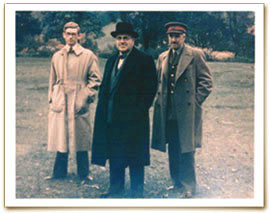John Tiltman facts for kids
Quick facts for kids
John Hessell Tiltman
|
|
|---|---|

British cryptanalysts Harry Hinsley, Sir Edward Travis, and John Tiltman in Washington D.C., November 1945
|
|
| Nickname(s) | "The Brig" |
| Born | 25 May 1894 London, England |
| Died | 10 August 1982 (aged 88) Hawaii, United States |
| Allegiance | United Kingdom |
| Service/ |
British Army |
| Years of service | 1914–1946 |
| Rank | Brigadier |
| Service number | 11225 |
| Unit | King's Own Scottish Borderers |
| Battles/wars | World War I World War II |
| Awards | Military Cross (1917) OBE (1930) CBE (1944) CMG (1954) Legion of Merit (1946) |
| Spouse(s) |
Tempe Robinson
(m. 1926) |
| Children | Tempe Anne Denzer |
Brigadier John Hessell Tiltman (born May 25, 1894 – died August 10, 1982) was a very important British Army officer. He worked in intelligence, which means he helped gather secret information. He was especially skilled at cryptanalysis, which is the art of breaking secret codes.
Tiltman worked with the Government Code and Cypher School (GC&CS) from the 1920s. This organization later became famous as Bletchley Park during World War II. His amazing code-breaking skills helped lead to major breakthroughs. For example, he worked with Bill Tutte to break the German teleprinter code, known as the "Tunny" code. This work was so important that it led to the creation of Colossus, one of the world's first digital computers.
Contents
John Tiltman's Life and Work
Early Life and Military Service
John Tiltman was born in London, England. His parents were from Scotland. In August 1914, he joined the British Army. He fought in World War I with the 6th Battalion King's Own Scottish Borderers.
He was very brave during the war. In May 1917, he won the Military Cross for his courage at the Third Battle of the Scarpe. He was also seriously wounded there. After this, he started working for MI1, which was a British intelligence unit.
Code-Breaking in India
From 1921 to 1929, Tiltman worked as a code-breaker for the British Indian Army. He was based at Army Headquarters in Simla, India. His team worked on breaking Russian diplomatic codes. These messages were sent from Moscow to places like Kabul, Afghanistan.
Tiltman was involved in many parts of this work. He helped direct how messages were collected and analyzed. He also worked directly on breaking the codes. He felt very lucky to gain so much experience in different areas of Signals Intelligence (SIGINT), which is about collecting and analyzing electronic signals.
World War II and Bletchley Park
After working as a civilian for a decade, Tiltman was called back to active military service. Even though he didn't go to university, his many years of experience in code-breaking were very valuable. He helped with many projects at GC&CS, which was later known as Bletchley Park.
He was considered one of the best code-breakers at Bletchley Park. He was especially good at breaking codes that didn't use machines. Tiltman played a key role in breaking the German Lorenz cipher, which the British called "Tunny." His work helped create new ways to attack this complex code. These methods were so advanced that they led to the design and building of the Colossus computer. Colossus was the first digital, programmable electronic computer.
Working with the United States
John Tiltman strongly believed that Britain and the United States should work together on code-breaking. He pushed for this cooperation early on. His efforts helped create a smooth and strong relationship between the two countries during World War II. This teamwork was very important for the war effort.
After the War
In 1944, Tiltman was promoted to Brigadier. He became the deputy director of GC&CS. After the war, in 1946, he continued his work as an assistant director at the Government Communications Headquarters (GCHQ). GCHQ was the new name for GC&CS.
From 1949 to 1954, Tiltman served as the Senior GCHQ Liaison Officer. He worked with the United States Army Security Agency in the US. He retired from the military as a Brigadier.
The Voynich Manuscript
In 1951, Tiltman met William Friedman. Friedman was a leading expert trying to understand the mysterious Voynich manuscript. This is an ancient book written in an unknown language. Tiltman himself analyzed the manuscript. Later, in the 1970s, he asked an NSA code-breaker named Mary D'Imperio to continue the work.
Mary D'Imperio's research led to her book, The Voynich Manuscript: An Elegant Enigma. This book is now a very important reference for anyone studying the Voynich Manuscript. Tiltman even wrote the introduction for her book.
Later Career and Legacy
Even after reaching the normal retirement age, Tiltman continued to work. He stayed with GCHQ from 1954 to 1964. From 1964 until 1980, he worked as a consultant and researcher for the National Security Agency (NSA) in the United States. In total, he spent 60 years working at the cutting edge of Signals Intelligence (SIGINT).
Tiltman was one of the few people who could adapt from breaking manual codes to understanding complex machine-based systems. He was known as "The Brig" by his friends and colleagues in both countries. He achieved many great things throughout his long career.
On September 1, 2004, John Tiltman was honored by being inducted into the "NSA Hall of Honor". He was the first non-US citizen to receive this recognition. The NSA praised him, saying, "His efforts at training and his attention to all the many facets that make up cryptology inspired the best in all who encountered him."

